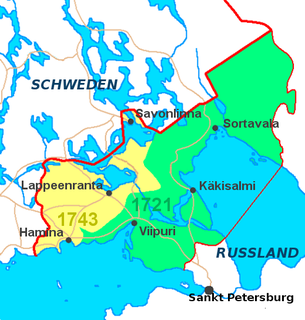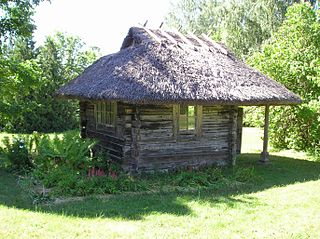 W
WThe Treaty of Åbo or the Treaty of Turku was a peace treaty signed between the Russian Empire and Sweden in Turku on 7. Augustjul./ 18. Augustgreg. 1743 in the end of the Russo-Swedish War of 1741-1743.
 W
WThe six-year Truce of Altmark was signed on 16 (O.S.)/26 (N.S.) September 1629 in the village of Altmark, in Poland, by the Polish-Lithuanian Commonwealth and Sweden, ending the Polish–Swedish War (1626–1629).
 W
WThe Second Treaty of Brömsebro was signed on 13 August 1645, and ended the Torstenson War, a local conflict that began in 1643 between Sweden and Denmark-Norway. Negotiations for the treaty began in February the same year.
 W
WThe Treaty of Cardis was a peace settlement made in 1661 between Tsardom of Russia and the Swedish Empire. This particular agreement ended the Russo–Swedish War (1656–1658). It took place in Cardis Manor in Estonia. Based on the terms of the treaty, Russia surrendered to Sweden all captured territories. Moreover, all vessels constructed at Kokenhausen for the failed Russian siege of Riga were destroyed. Overall, the Peace of Cardis maintained the territorial accords of the Treaty of Stolbovo.
 W
WThe Treaty of Fredrikshamn or the Treaty of Hamina was a peace treaty concluded between Sweden and Russia on 17 September 1809. The treaty concluded the Finnish War and was signed in the Finnish town of Hamina. Russia was represented by Nikolai Rumyantsev and David Alopaeus, while Sweden by Infantry General Kurt von Stedingk and Colonel Anders Fredrik Skjöldebrand.
 W
WThe Treaty of Kiel or Peace of Kiel was concluded between the United Kingdom of Great Britain and Ireland and the Kingdom of Sweden on one side and the Kingdoms of Denmark and Norway on the other side on 14 January 1814 in Kiel. It ended the hostilities between the parties in the ongoing Napoleonic Wars, where the United Kingdom and Sweden were part of the anti-French camp while Denmark–Norway was allied to France.
 W
WThe Treaty of Knäred was signed on 21 January 1613 and ended the Kalmar War (1611–1613) between Denmark-Norway and Sweden. The peace negotiations came about under an English initiative. The peace was guaranteed by King James I of England and VI of Scotland.
 W
WThe Treaty of Labiau was a treaty signed between Frederick William I, Elector of Brandenburg and Charles X Gustav of Sweden on 10 November (O.S.) / 20 November (N.S.) 1656 in Labiau. With several concessions, the most important being the elevation of Frederick William I from a Swedish vassal to a full sovereign in the Duchy of Prussia and in Ermland, Charles X Gustav strove to "buy Frederick William's support" in the ongoing Second Northern War.
 W
WThe Treaty of Lödöse was a peace treaty between the Swedish king Eric XI and the Norwegian king Haakon IV. The treaty was negotiated between King Haakon and the Jarl of Sweden, Birger Magnusson, in the town of Lödöse, during the summer of 1249. The main purpose of the treaty was to prevent mutual hostility from escalating into war. Some factions of the Swedish nobility wanted to attack Norway in retribution for a raid by King Haakon, which had targeted Norwegian rebels in the Swedish province of Värmland 24 years earlier.
 W
WThe Peace of Lund, signed on 16 September (O.S.) / 26 September 1679, was the final peace treaty between Denmark-Norway and the Swedish Empire in the Scanian War.
 W
WThe Treaty of Nöteborg, also known as the Treaty of Oreshek, is a conventional name for the peace treaty signed at Oreshek on 12 August 1323. It was the first settlement between Sweden and the Novgorod Republic regulating their border. Three years later, Novgorod signed the Treaty of Novgorod with the Norwegians.
 W
WThe Treaty of Nystad was the last peace treaty of the Great Northern War of 1700–1721. It was concluded between the Tsardom of Russia and the Swedish Empire on 10 September [O.S. 30 August] 1721 in the then Swedish town of Nystad. Sweden had settled with the other parties in Stockholm and in Frederiksborg (1720).
 W
WThe Treaty or Peace of Oliva of 23 April (OS)/3 May (NS) 1660 was one of the peace treaties ending the Second Northern War (1655-1660). The Treaty of Oliva, and the Treaty of Copenhagen in the same year, and the Treaty of Cardis in the following year, marked the high point of the Swedish Empire.
 W
WThe Treaties of Örebro, the full names being the Treaty of Peace, Union, and Friendship, between His Britannic Majesty and the Emperor of all the Russias and the Treaty of Peace, Union, and Friendship, between His Britannic Majesty and the King of Sweden, were both signed on the same day, 18 July 1812, in Örebro, Sweden. They formally end the Anglo-Russian War (1807–1812) and the Anglo-Swedish War (1810–1812).
 W
WThe Treaty of Paris of 1815 was signed on 20 November 1815 following the defeat and second abdication of Napoleon Bonaparte. In February, Napoleon had escaped from his exile on Elba; he entered Paris on 20 March, beginning the Hundred Days of his restored rule. After France's defeat at the hands of the British and the Prussians in the Battle of Waterloo, Napoleon was persuaded to abdicate again, on 22 June. King Louis XVIII, who had fled the country when Napoleon arrived in Paris, took the throne for a second time on 8 July.
 W
WThe Treaty of Roskilde was concluded on 26 February (OS) or 8 March 1658 (NS) during the Second Northern War between Frederick III of Denmark–Norway and Karl X Gustav of Sweden in the Danish city of Roskilde. After a devastating defeat, Denmark-Norway was forced to give up a third of its territory to save the rest, the ceded lands comprising Blekinge, Bornholm, Bohuslän (Båhuslen), Scania (Skåne) and Trøndelag, as well as her claims to Halland.
 W
WThe Treaty of Stolbovo was a peace treaty which ended the Ingrian War which had been fought between Sweden and Russia between 1610 and 1617.
 W
WThe Treaty of Teusina, Tyavzin or Tyavzino, also known as the Eternal Peace with Sweden in Russia, was concluded by Russian diplomats under boyar Afanasiy Pushkin and ambassadors of the Swedish king at the village of Tyavzino in Ingria on 18 May 1595 to end the Russo-Swedish War (1590–95) between the powers.
 W
WThe Peace of Travendal was a peace treaty concluded at the outset of the Great Northern War on 18 August 1700 between the Swedish Empire, Denmark–Norway and Holstein-Gottorp in Traventhal. Denmark had to return Holstein-Gottorp to its duke, a Swedish ally, and to leave the anti-Swedish alliance. The Danes only reentered the war after Sweden's major defeat in the Battle of Poltava, 1709, having used the time to reform their army. The treaty was guaranteed by France, the Holy Roman Empire, the United Provinces (Netherlands) and Great Britain.
 W
WThe Treaties of Roskilde of 18 and 22 November 1568 were peace treaties between the kingdoms of Denmark-Norway and the allied Free and Hanseatic City of Lübeck on one side, and the Swedish kingdom on the other side, supposed to end the Northern Seven Years' War after the de facto succession of the later king John III of Sweden. Negotiated on John's initiative, he refused ratification, viewing the concessions his envoys made in Roskilde as too far-reaching. Most notably these concessions included Swedish obligations to pay Denmark her war costs and to cede Swedish Estonia. Thus, the war dragged on until it was concluded by the Treaty of Stettin (1570).
 W
WThe Treaty of Gotland was a peace treaty settled by the Swedish king Magnus III to resolve a conflict between the peasants of the Swedish island Gotland, and the burghers of the island's largest city, Visby. The conflict is believed to have stemmed from rivalry over the lucrative Gutnish trade on the Baltic sea and disagreement between the two factions over duties levied by the burghers on all goods entering Visby. The peasants were aggrieved over the new duties that had been introduced in 1288, after completion of the City wall of Visby. Many of the Visby burghers were Germanic tradesmen associated with what would eventually become the Hanseatic League.
 W
WThe Peace of Westphalia is the collective name for two peace treaties signed in October 1648 in the Westphalian cities of Osnabrück and Münster. They ended the Thirty Years' War and brought peace to the Holy Roman Empire, closing a calamitous period of European history that killed approximately eight million people.